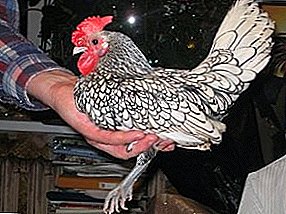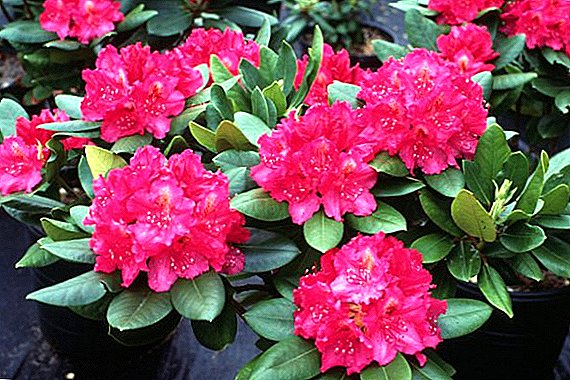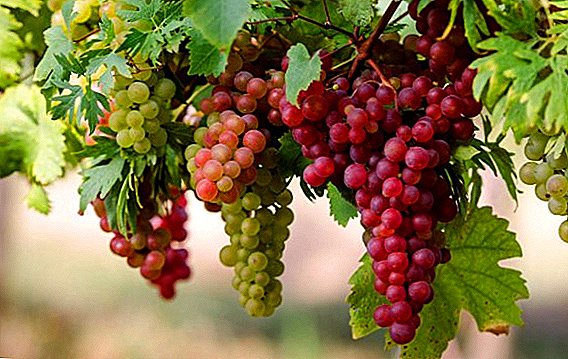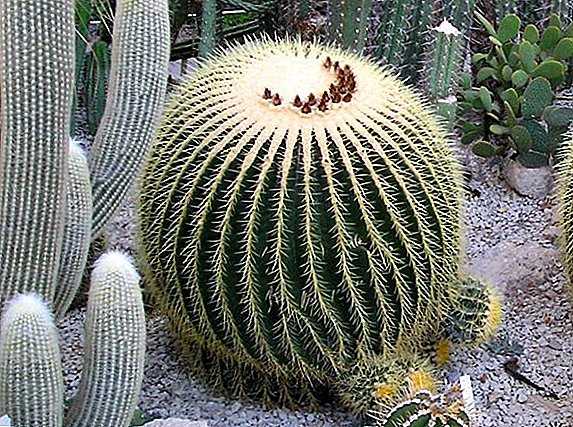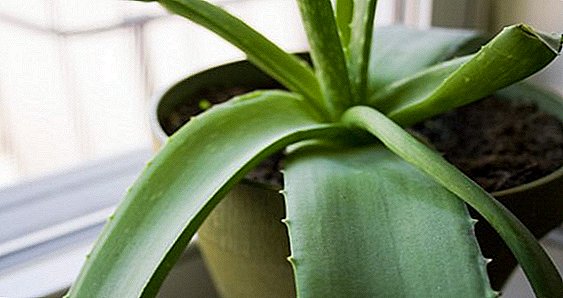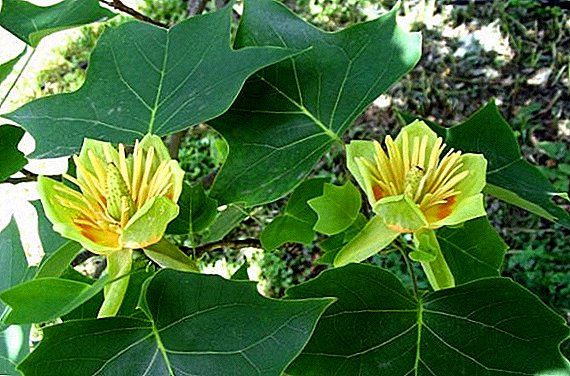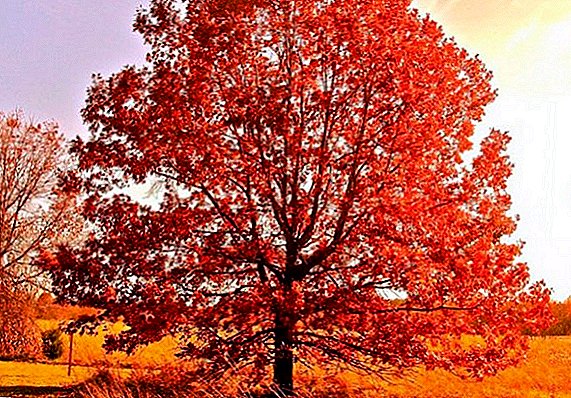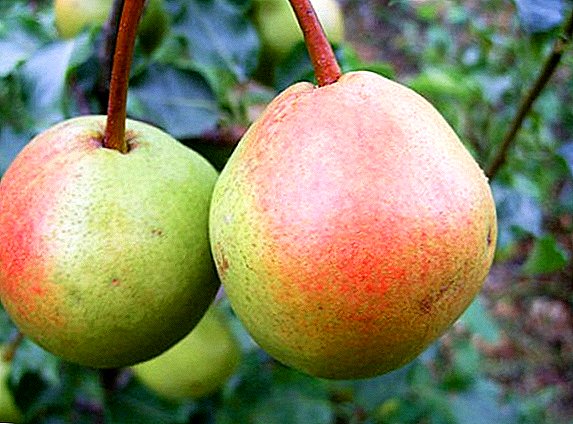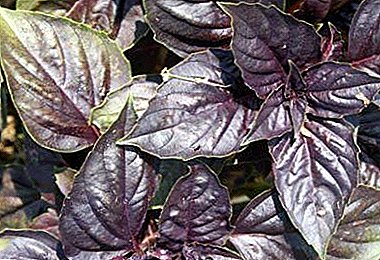
Basil is a popular spicy plant that has about 100 varieties. To determine such a diversity is very difficult.
Therefore, today's topic of our article will be devoted to one of its varieties, which will surprise you with its healing properties and appearance.
In the article we will tell in detail about such a variety as Ararat: external characteristics, benefits and contraindications, features of cultivation from seeds, as well as when to plant a plant.
Variety description and its history
This variety has large leaf plates of purple hue. Belongs to plants of an average ripening period. The bush is not very large, both in height and in width - it grows in length up to 60 centimeters.
A characteristic feature of basil Ararat is the presence of a large amount of essential oils and carotene.
Basil was known to people even thousands of years ago. And this plant came to Russia in the 18th century, however, it was not immediately used in cooking, but only in the field of cosmetology and traditional medicine.
Basil Ararat does not survive severe frosts, so the spice bushes need to be dug up at the end of September and transferred to domestic conditions. Then in the winter, you can enjoy the scent of the plant. It is undesirable to plant a spice bush at the same place for more than three years in a row..
A photo
Below you will see a photo of this basilica:



Differences from other varieties
By taste, Ararat is sharper than the delicate green varieties. The aroma of the purple variety is also more pronounced, even a little harsh. The green plant is most often dried, and purple is added to pickled dishes.
Therapeutic and beneficial properties, chemical composition
The product contains the following substances (calculated per 100 grams):
- proteins - 3.15 g;
- fats - 0.64 g;
- carbohydrates - 2.65 g;
- dietary fiber - 1.65 g;
- ash - 1.49 g;
- water - 92.06 g;
- monosaccharides and disaccharides - 0.3 g;
- saturated fatty acids - 0.04 g
In addition, basil Ararat is rich in many chemical elements and vitamins:
- vitamin complex:
- β-carotene - 3.142 mg;
- A - 264 mcg;
- B1 (thiamine) - 0.034 mg;
- B2 - 0.076 mg;
- B5 - 0.209 mg;
- B6 - 0.155 mg;
- B9 - 68 mcg;
- C - 18 mg;
- E - 0.8 mg;
- K - 414.8 mcg;
- PP - 0.902 mg;
- Choline - 11.4 mg.
 macronutrients:
macronutrients:- calcium - 177 mg;
- magnesium 64 mg;
- sodium, 4 mg;
- potassium - 295 mg;
- phosphorus - 56 mg.
- trace elements:
- iron - 3.17 mg;
- zinc - 0.81 mg;
- copper - 385 mcg;
- manganese - 1,148 mg;
- selenium - 0.3 micrograms.
Benefit
- possesses antibacterial and disinfecting properties;
- good antidepressant;
- tones the body;
- used as an aphrodisiac;
- soothes the nervous system;
- used in aromatherapy;
- improves cardiovascular and digestive systems;
- is the prevention of the development of hemorrhoids and cancer;
- improves eyesight and increases the protective properties of the body;
- helps to eliminate toxins;
- fights headaches;
- improves skin condition and fights age-related changes.
Side effects
If you eat too much of this spice in a day, the following side effects may occur:
- work disorder and irritation of the gastric mucosa;
- convulsions;
- allergic manifestations.
Contraindications
 There are contraindications that use basil is strongly discouraged:
There are contraindications that use basil is strongly discouraged:
- gestation period;
- serious deviations in the work of the cardiovascular system, especially after suffering cardiac ailments;
- in the formation of blood clots in the blood;
- with poor blood clotting;
- if there is an allergy to the product.
How to use and apply?
Due to the spicy taste of basil, Ararat it is most often used in the preparation of Asian and Caucasian dishes. This distinguishes it from green basil, which is added even to dessert dishes for the tenderness of taste. However, Ararat has found its use in European cuisine: it is added to soups, hot dishes, sauces, marinades and seasonings, as well as to decorate a dish.
You can use basil either fresh or dried.. However, experienced chefs say that green basil is more suitable for drying. In all dishes, the plant is used as a seasoning.
Violet basil essential oil is used in medicine and cosmetology.
Important! In large quantities and on an empty stomach should not eat spice.
Care during outdoor cultivation
Temperature
Basil Ararat is a very thermophilic plant that reacts sharply to a decrease in air temperature. So, if the air temperature is 10-17 degrees, the plant will stop its growth. And at lower temperatures, the spice dies. The most optimal temperature for basil is 18-27 degrees Celsius.
Watering
The described plant loves wet soil. However, it is impossible to bring to the formation of wetland - in this case, the root system will rot. In irrigation mode it is better to focus on the condition of the top layer of soil. - as soon as it dries well, you need to water the plant. It is better to have separated water for this procedure.
Shine
Choose a plot for planting basil as much as possible lit, without any shading. Since the formation of a beautiful purple hue of leaf plates requires a large amount of light.
Top dressing
 To achieve abundant growth of basil Ararat, it must be periodically fed. It is necessary to carry out the procedure of feeding once a month until the formation of flower buds.
To achieve abundant growth of basil Ararat, it must be periodically fed. It is necessary to carry out the procedure of feeding once a month until the formation of flower buds.
The first time fertilizers are applied two weeks after transplanting in open ground. If the seeds were sown immediately in open ground, fertilizing is carried out a month after the first seedlings emerge. Use as a fertilizer solution nitrophoska (10 liters of water must be diluted with two tablespoons of top dressing).
Fertilizer consumption: 4 liters per 1 square meter.
Loosening
Once a week you need to loosen the soil, so as not to form a dry crust, interfering with the passage of air. It is necessary to loosen the soil after watering, but you need to wait until the soil dries out a little. With the process of loosening you need to combine the procedure for weed removal.
Peculiarities of home care
Such care is nothing special differs from the open ground. The main thing to add to the tank drainage layer and put it on a bright place, away from heating appliances.
How to plant in open ground?
Seeds
Time for sowing is chosen such that the risk of night frost has passed. This usually happens by the end of May. In the northern parts of the country even later - by mid-June.
- Grooves are made for planting to a depth of 2 centimeters.
- These grooves are plentifully watered, allowed to dry a little.
- After that, the seeds are placed in the grooves at a distance of 10 centimeters from each other.
From above only slightly sprinkled with soil.
Attention! Before planting, the soil should be dug to a depth of 20 centimeters. At this time, peat and organic fertilizer are introduced into the earth: compost or humus.
Before planting, seeds should be soaked in warm water for a day and allowed to dry, spreading them on gauze fabric.
Seedlings
- Transferring seedlings to open ground is best in the evening. Before planting, you need to prepare the wells to a depth of 10 centimeters.
- Planted seedlings need at a distance of 20 cm from each other. And the distance between the rows of basil should be 40 cm.
- The wells before disembarking abundantly watered with the same separated water.
When and how to harvest?
The main sign that the basil Ararat is ready to collect, are the buds that have just begun to form. This usually happens in August. Do not bring to the buds opened, because after that many useful properties will go into flowers. And before the frost, the plant is also not worth keeping on the site - the whole basil will die. Harvesting is necessary just by cutting the shoots of the desired length..
Where to buy seeds?
Basil - quite a popular plant, so buy its seeds will have no difficulty. They can be purchased at any store that specializes in selling seeds. The cost of one package weighing 0.3-1 grams is 10-15 rubles. When buying, it is important to pay attention to the integrity of the package and the shelf life of the seed.
Diseases and pests
 Basil has a high immunity to various ailments, but still some of them can be encountered while growing spices.
Basil has a high immunity to various ailments, but still some of them can be encountered while growing spices.
Of the diseases of basil include the following:
- Fusarium;
- gray rot;
- blackleg.
Fight them better folk remedies. For example, infusion of husk. Of the pests plant attack aphid and field bug. Fungicides can be used to destroy them.
Basil - a plant with a huge amount of vitamins and useful elements. This spice grows easily at home, so any agronomist can grow it.


 macronutrients:
macronutrients: